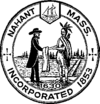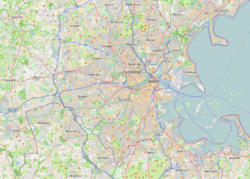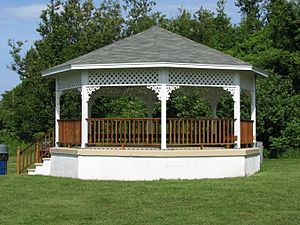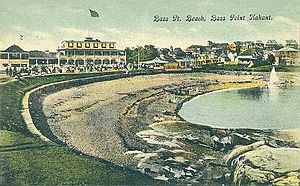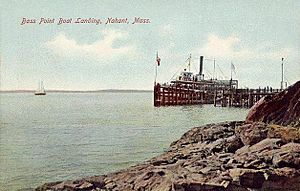Nahant, Massachusetts facts for kids
Quick facts for kids
Nahant, Massachusetts
|
||
|---|---|---|
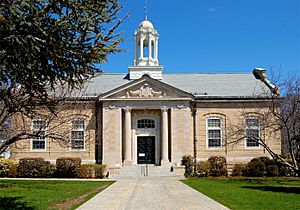
Town Hall of Nahant
|
||
|
||
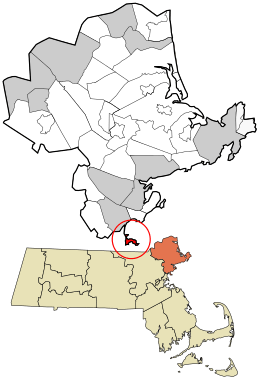
Location in Essex County and the state of Massachusetts.
|
||
| Country | United States | |
| State | Massachusetts | |
| County | Essex | |
| Settled | 1630 | |
| Incorporated | March 29, 1853 | |
| Government | ||
| • Type | Open town meeting | |
| Area | ||
| • Total | 15.5 sq mi (40.1 km2) | |
| • Land | 1.0 sq mi (2.7 km2) | |
| • Water | 14.4 sq mi (37.4 km2) | |
| Elevation | 50 ft (15 m) | |
| Population
(2020)
|
||
| • Total | 3,334 | |
| • Density | 3,198.2/sq mi (1,234.8/km2) | |
| Time zone | UTC-5 (Eastern) | |
| • Summer (DST) | UTC-4 (Eastern) | |
| ZIP code |
01908
|
|
| Area code(s) | 339 / 781 | |
| FIPS code | 25-43580 | |
| GNIS feature ID | 0618304 | |
Nahant (/nəˈhɑːnt/) is a small town in Essex County, Massachusetts, United States. It is known for being the smallest town in Essex County by population. Nahant is also the smallest town in Massachusetts by land area.
This town is mostly a place where people live. It sits on a special type of landform called a peninsula. This peninsula has two parts, "Little Nahant" and "Big Nahant." They are connected to the mainland by a narrow sandy path called a causeway, which is like a bridge for cars. Many popular beaches are found along the shores, including "Long Beach" and "Short Beach."
Contents
History of Nahant
The area around Nahant has been home to people for thousands of years. We know little about this time before Europeans arrived in the early 1600s.
Early European Exploration and Settlement
In 1605, explorer Samuel de Champlain visited Nahant. He noted that the coast had much cleared land. Native people grew Indian corn there.
By the 1630s, English settlers came to the area. The Naumkeag lived nearby. Their leader, Sagamore James (also known as Montowampate), lived at the Saugus River. Another leader, Poquanum (Blacke William), may have controlled Nahant island. Around 1632, he allowed Thomas Dexter to use the island. The name Nahant might mean "at the point" or "twin islands."
English colonists first settled Nahant in 1630. Servants of Isaac Johnson grazed cattle on the land. People from Lynn also used it for their animals. In 1633, Nahant was listed as a "noted Habitation" in New England.
Nahant Becomes a Town
Before 1800, only three homes existed on the island. The first hotel was built in 1802. By 1817, a steamboat traveled daily between Boston and Nahant.
Nahant was originally part of Lynn. In 1853, it became a separate town. This happened when a movement to ban alcohol threatened the summer resort business. In the late 1800s, Nahant became a popular summer spot for wealthy people. It also had some of the country's first amusement parks. Famous poet Henry Wadsworth Longfellow spent summers here. Geologist Louis Agassiz also lived in Nahant.
During World War II, East Point in Nahant had a coastal artillery battery. This was a place with big guns to defend the coast. Today, it is a town park. It is also home to the Marine Science Center for Northeastern University.
Community Improvements in Nahant
The old Nahant Life-Saving Station was updated in 2004. A new War Memorial was also built nearby.
In 2003, the Valley Road School was fixed up. It became the Nahant Community Center. This center now hosts many local activities. It is also home to the local Boy Scout Troop 50.
In 2005, the town rebuilt the Bailey's Hill Gazebo. It is now called the Calantha Sears Gazebo. The original gazebo was built in 1976. Local residents helped rebuild it with funding from the Woman's Club of Nahant.
Geography and Transportation
Nahant is a unique place. It is a tied island, which means it's connected to the mainland by a natural land bridge. This land bridge is called a tombolo. Even though it's connected, people often call Nahant an "island."
Nahant's Location and Surroundings
Nahant is linked to the city of Lynn by a causeway. This causeway is the main road into town. The town is surrounded by water. To the east is Nahant Bay. To the south is Nahant Harbor. To the west is Lynn Harbor. All these waters lead to Broad Sound and Massachusetts Bay.
The town has a main part and "Little Nahant" to the north. The area between Black Rock Point and Bass Point is where most people live. Nahant has ten beaches along its coast. The biggest ones are Nahant Beach and Long Beach. These are along the eastern side of the causeway. Short Beach is also very popular in summer. The town also has small parks and the Kelly Greens Golf Course.
Nahant is special because it only touches one other town by land, which is Lynn. It is about 14 miles northeast of Boston. It is also 9 miles south of Salem.
Getting Around Nahant
There are no major highways directly in Nahant. The nearest state road is Route 129 in Lynn. Major highways like U.S. Route 1 and Interstates 95 and 128 are further away.
For public transport, the MBTA bus route 439 serves Nahant. This bus goes into Lynn. From Lynn, you can take the MBTA Commuter Rail to Boston's North Station. Some buses also go to Wonderland station. There, you can connect to the MBTA Blue Line subway. The closest airport is Logan International Airport in Boston.
Population and People
Nahant is a small town with a close-knit community. The population was 3,334 people in 2020. This makes it the smallest town in Essex County by population.
| Historical population | ||
|---|---|---|
| Year | Pop. | ±% |
| 1860 | 380 | — |
| 1870 | 475 | +25.0% |
| 1880 | 808 | +70.1% |
| 1890 | 880 | +8.9% |
| 1900 | 1,152 | +30.9% |
| 1910 | 1,184 | +2.8% |
| 1920 | 1,318 | +11.3% |
| 1930 | 1,654 | +25.5% |
| 1940 | 1,835 | +10.9% |
| 1950 | 2,679 | +46.0% |
| 1960 | 3,960 | +47.8% |
| 1970 | 4,119 | +4.0% |
| 1980 | 3,947 | −4.2% |
| 1990 | 3,828 | −3.0% |
| 2000 | 3,632 | −5.1% |
| 2010 | 3,410 | −6.1% |
| 2020 | 3,334 | −2.2% |
| 2022* | 3,289 | −1.3% |
| * = population estimate. Source: United States Census records and Population Estimates Program data. | ||
The town has a mix of ages. In 2000, about 18.6% of the population was under 18. About 19.4% were 65 or older. The average age in Nahant was 45 years.
Education
Students in Nahant attend Johnson Elementary School for preschool through sixth grade. After sixth grade, students go to schools in nearby Swampscott. This includes Swampscott High School for grades seven through twelve.
Arts and Culture
Nahant has several interesting places and events.
Places of Interest
- The Henry Cabot Lodge House is a National Historic Landmark. It is located at 5 Cliff Street.
- Greenlawn Cemetery is a historic burial ground.
- The Nahant Historical Society Museum is in the Nahant Community Center.
- The Northeastern University Marine Science Center is at East Point. It also has Nahant's observatory. The movie Shutter Island filmed lighthouse scenes here in 2008.
- The World War II Bunkers are inside Trimountain and East Point. They were built to defend Boston Harbor during the war. During the Cold War, they held Nike missiles to protect Boston.
Annual Events
- The annual Fourth of July fireworks show is a big event.
- The Nahant Christmas Parade started in 1996. It is one of the town's biggest celebrations.
- The Memorial Day Parade is a special day. Former residents come back to watch the parade. It includes playing Taps at the cemetery and cannon fire at Tudor Wharf.
Notable People
Many interesting people have connections to Nahant:
- Cleveland Amory (1917–1998), an author and animal rights activist.
- Henry Cabot Lodge Jr. (1902–1985), a politician born in Nahant.
- Barbra Fuller (1921–2024), an actress born in Nahant.
- Jason Mantzoukas (born 1972), an actor raised in Nahant.
- Glenn Sherlock (born 1960), a baseball player and coach.
- Frederic Tudor (1783–1864), whose summer home is now the Nahant Country Club.
Images for kids
-
Nahant Hotel, from Boston Monthly Magazine, 1825. Engraving by J.R. Penniman
See also
 In Spanish: Nahant (Massachusetts) para niños
In Spanish: Nahant (Massachusetts) para niños


